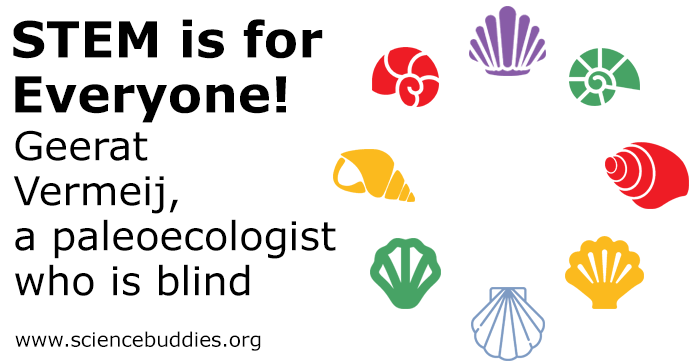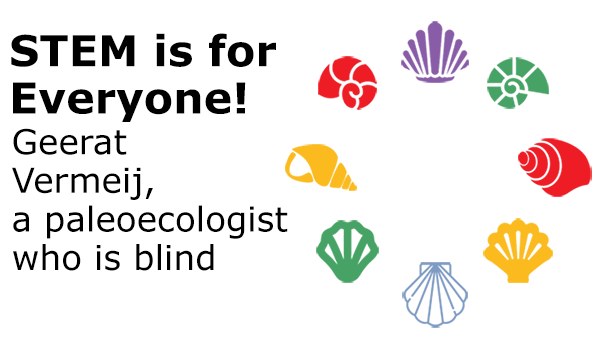STEM is for Everyone: Geerat Vermeij, a Paleoecologist who is Blind
This scientist views seashells as works of art and an incredible key to understanding the past. Although he is blind, he has been studying shells for decades.

If you have ever been to the seashore, you may have walked along the beach looking for shells. If you were lucky enough to find a few, you may have noticed how different each one was. Even two shells that might have seemed similar at first were probably very different when you looked more closely. Shells, mostly made of calcium carbonate, are really the hard exterior, the exoskeleton, of marine mollusks. A shell helps protect an animal from predators, and the ways in which shells have evolved over the years tells scientists a great deal about marine life.
When looking at shells, you might first notice their size, or whether they have a hinged (bivalve) opening, like oysters, or a single opening that spirals from the inside out, like a snail's shell. You can learn a lot by looking at shells and observing shell colors (which may hold clues to what an animal ate or where it lived) and features like ridges, spikes, and lines on the exterior of the shell.
Using only your sense of touch to observe all of these details about a shell may sound challenging, but Dr. Geerat Vermeij, a world-renowned scientist who is blind, has been studying shells by touch for decades.
Refining the Sense of Touch
Dr. Vermeij, an evolutionary biologist and paleocologist, is a distinguished professor of geology at the University of California at Davis. He has collected shells from all over the world as part of his study of the evolution of mollusks over millions of years, a process that can be chronicled by studying the defensive strategies evident in shell adaptations and variations.
Dr. Vermeij had childhood glaucoma and has been blind since the age of 3. Always curious, he used his sense of touch to observe the world around him. Dr. Vermeij says that his parents were interested in nature and natural history, and they described everything to him, especially things that he couldn't touch. He has said that he began "seriously" collecting shells at age 10 after being shown a set of shells by his 4th-grade teacher. "I was just enthralled. They were so elegant, so beautiful, such wonderful contrasts between the outsides and the insides, and so on. The shapes were out of this world. Just a whole dimension of beauty I was unfamiliar with. It was a wonderful way to get into the real biology of living things and ultimately the history of living things," says Dr. Vermeij (in the video above).
Dr. Vermeij can't see the shells he studies, but he observes them closely using his fingers. "Shells are basically perfectly designed to be touched and appreciated," he says. According to Dr. Vermeij, shells tell a story and hold clues to the history and evolution of living things. "They tell a story about their own lives and about the lives of other organisms and, ultimately, the geological past," he says. "I could look at a shell a hundred times and still see something new in it."
For Dr. Vermeij, this process of looking and carefully observing shells is an important first step in asking scientific questions. "The skill of observation is completely central to what I do, and it is a skill. It is really something to be honed. And I don't just mean touching things. I mean listening and smelling and seeing." In an interview with NPR, Dr. Vermeij said that being blind has made him a better scientist. "Being aware, to me, is so essential in science because by being aware, you're made a better observer, and observation is where really all of it begins, to me."
Explore with Student Science
Students interested in Dr. Vermeij's story and paleontology or geology may enjoy exploring projects like these:
- Get Some Practice at 'Fossil' Reconstruction with Owl Pellets
- Fantastic Fossilization! Discover the Conditions For Creating the Best Cast Fossils
- Sorting Out Sedimentation
- How Old Is That Rock? Roll the Dice & Use Radiometric Dating to Find Out
- Jumping For Geodes: Can You Tell the Inside from the Outside?
Survival and Adaptation
While focused on shells, much of Dr. Vermeij's work is about survival. Students interested in this angle of inquiry (or teachers planning units on survival and adaptation) can learn more with the following lessons and projects:
- Water Striders: Survival Adaptations
- What Animals Need to Survive
- Build a Bird Feeder to Discover What Animals Need
- M&M Survival Challenge
- The Swimming Secrets of Duck Feet
Extra! To help students better understand how Braille works, try this hands-on science activity.
Related STEM Careers
The following career profiles offer additional information about careers related to Dr. Vermeij's field of study:
Learn More
Books by Geerat Vermeij
Additional resources
- Geerat J. Vermeij (University of California, Davis)
- Geerat Vermeij | Curiosity Project (video)
- INSIGHT UNPARALLELED
- Blind Biologist Finds Clues to Human Societies in Shells (NPR)
- Seashells inspired career of lauded evolutionary geologist
- Geerat Vermeij, Evolutionary Biologist, Reading A Shell’s Story (video)
- SCIENTIST AT WORK: Geerat Vermeij; Getting The Feel of A Long Ago Arms Race (New York Times)
The STEM is for Everyone Series
For more information about this series of profiles of scientists with disabilities and to learn about other scientists and engineers, see the following posts:
- STEM is for Everyone: Scientists with Disabilities
- STEM is for Everyone: Nicholas Saunderson, Blind Mathematician
- STEM is for Everyone: Temple Grandin, Animal Scientist with Autism
- STEM is for Everyone: Geerat Vermeij, a Paleoecologist who is Blind
- STEM is for Everyone: Farida Bedwei, a Computer Scientist with Cerebral Palsy
- STEM is for Everyone: Ralph Braun, Engineer
- STEM is for Everyone: Wanda Díaz-Merced, Astrophysicist
- STEM is for Everyone: Richard Mankin, Entomologist
- STEM is for Everyone: Helen Taussig, Pediatric Cardiologist
- STEM is for Everyone: Annie Jump Cannon, Classifier of Stars
- STEM is for Everyone: Jane Goodall, Zoologist
This post is part of our STEM is for Everyone: Scientists with Disabilities series. This series is made possible by generous support from Mitsubishi Electric America Foundation, a non-profit foundation jointly funded by Mitsubishi Electric Corporation of Japan and its US affiliates, working to make changes for the better by empowering youth with disabilities to lead productive lives.
Categories:
You Might Also Enjoy These Related Posts:
- Women in STEM! More than 60 Scientists and Engineers for Women's History Month
- Black History Month - Learn More About these 38 Scientists for Black History Month!
- Native American Scientists and Engineers--Native American Heritage Month in Science Class
- Hispanic Scientists and Engineers - Hispanic Heritage Month
- Inspiring AAPI Scientists and Engineers - Asian American and Native Hawaiian/Pacific Islander Heritage Month
- Thousands of Tall Paper Towers (and Lots of Tape!)
- STEM is for Everyone: Jane Goodall, Zoologist
- STEM is for Everyone: Annie Jump Cannon, Classifier of Stars











